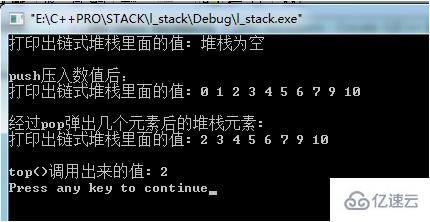这篇文章将为大家详细讲解有关java实现堆栈的方法,文章内容质量较高,因此小编分享给大家做个参考,希望大家阅读完这篇文章后对相关知识有一定的了解。
在计算机领域,堆栈是一个不容忽视的概念,堆栈是一种数据结构。堆栈都是一种数据项按序排列的数据结构,只能在一端(称为栈顶(top))对数据项进行插入和删除。
堆栈有3种实现方式,实现方式为:
一、动态数组堆栈
头文件还是用stack.h,改动的并不是很多,增加了stack_size变量取代STACK_SIZE来保存堆栈的长度,数组由一个指针来代替,在全局变量下缺省为0。
create_stack函数首先检查堆栈是否已经创建,然后才分配所需数量的内存并检查分配是否成功。destroy_stack函数首先检查堆栈是否存在,已经释放内存之后把长度和指针变量重新设置为零。is_empty 和 is_full 函数中添加了一条断言,防止任何堆栈函数在堆栈被创建之前就被调用。
d_stack.c源代码如下:
[cpp] view plain copy
/*
** 动态分配数组实现的堆栈程序 d_stack.c
** 堆栈的长度在创建堆栈的函数被调用时候给出,该函数必须在任何其他操作堆栈的函数被调用之前条用。
*/
#include"stack.h"
#include<stdio.h>
#include<malloc.h>
#include<assert.h>
/*
** 用于存储堆栈元素的数组和指向堆栈顶部元素的指针
*/
static STACK_TYPE *stack;
static int stack_size;
static int top_element = -1;
/* create_stack */
void create_stack(size_t size)
{
assert(stack_size == 0);
stack_size = size;
stack = (STACK_TYPE *)malloc(stack_size * sizeof(STACK_TYPE));
if(stack == NULL)
perror("malloc分配失败");
}
/* destroy */
void destroy_stack(void)
{
assert(stack_size > 0);
stack_size = 0;
free(stack);
stack = NULL;
}
/* push */
void push(STACK_TYPE value)
{
assert(!is_full());
top_element += 1;
stack[top_element] = value;
}
/* pop */
void pop(void)
{
assert(!is_empty());
top_element -= 1;
}
/* top */
STACK_TYPE top(void)
{
assert(!is_empty());
return stack[top_element];
}
/* is_empty */
int is_empty(void)
{
assert(stack_size > 0);
return top_element == -1;
}
/* is_full */
int is_full(void)
{
assert(stack_size > 0);
return top_element == stack_size - 1;
}
/*
** 定义一个print函数,用来打印堆栈里面的元素。
*/
void print(void)
{
int i;
i = top_element;
printf("打印出动态数组堆栈里面的值: ");
if(i == -1)
printf("这是个空堆栈\n");
while(i!= -1)
printf("%d ",stack[i--]);
printf("\n");
}
int main(void)
{
create_stack(50);
print();
push(10); push(9); push(7); push(6); push(5);
push(4); push(3); push(2); push(1); push(0);
printf("push压入数值后:\n");
print();
printf("\n");
pop();
pop();
printf("经过pop弹出几个元素后的堆栈元素:\n");
print();
printf("\n");
printf("top()调用出来的值: %d\n",top());
destroy_stack();
return 1;
}结果如下图:

二、静态数组堆栈
在静态数组堆栈中,STACK_SIZE表示堆栈所能存储的元素的最大值,用top_element作为数组下标来表示堆栈里面的元素,当top_element == -1的时候表示堆栈为空;当top_element == STACK_SIZE - 1的时候表示堆栈为满。push的时候top_element加1,top_element == 0时表示第一个堆栈元素;pop的时候top_element减1。
a_stack.c 源代码如下:
[cpp] view plain copy
/*
**
** 静态数组实现堆栈程序 a_stack.c ,数组长度由#define确定
*/
#include"stack.h"
#include<assert.h>
#include<stdio.h>
#define STACK_SIZE 100 /* 堆栈最大容纳元素数量 */
/*
** 存储堆栈中的数组和一个指向堆栈顶部元素的指针
*/
static STACK_TYPE stack[STACK_SIZE];
static int top_element = -1;
/* push */
void push(STACK_TYPE value)
{
assert(!is_full()); /* 压入堆栈之前先判断是否堆栈已满*/
top_element += 1;
stack[top_element] = value;
}
/* pop */
void pop(void)
{
assert(!is_empty()); /* 弹出堆栈之前先判断是否堆栈已空 */
top_element -= 1;
}
/* top */
STACK_TYPE top(void)
{
assert(!is_empty());
return stack[top_element];
}
/* is_empty */
int is_empty(void)
{
return top_element == -1;
}
/* is_full */
int is_full(void)
{
return top_element == STACK_SIZE - 1;
}
/*
** 定义一个print函数,用来打印堆栈里面的元素。
*/
void print(void)
{
int i;
i = top_element;
printf("打印出静态数组堆栈里面的值: ");
if(i == -1)
printf("这是个空堆栈\n");
while(i!= -1)
printf("%d ",stack[i--]);
printf("\n");
}
int main(void)
{
print();
push(10); push(9); push(7); push(6); push(5);
push(4); push(3); push(2); push(1); push(0);
printf("push压入数值后:\n");
print();
printf("\n");
pop();
pop();
printf("经过pop弹出几个元素后的堆栈元素:\n");
print();
printf("\n");
printf("top()调用出来的值: %d\n",top());
return 1;
}结果如下图:

三、链式堆栈
由于只有堆栈顶部元素才可以被访问,因此适用单链表可以很好实现链式堆栈,而且无长度限制。把一个元素压入堆栈是通过在链表头部添加一个元素实现。弹出一个元素是通过删除链表头部第一个元素实现。由于没有长度限制,故不需要create_stack函数,需要destroy_stack进行释放内存以避免内存泄漏。
头文件stack.h不变,l_stack.c源代码如下:
[cpp] view plain copy
/*
** 单链表实现堆栈,没有长度限制
*/
#include"stack.h"
#include<stdio.h>
#include<malloc.h>
#include<assert.h>
#define FALSE 0
/*
** 定义一个结构以存储堆栈元素。
*/
typedef struct STACK_NODE
{
STACK_TYPE value;
struct STACK_NODE *next;
} StackNode;
/* 指向堆栈中第一个节点的指针 */
static StackNode *stack;
/* create_stack */
void create_stack(size_t size)
{}
/* destroy_stack */
void destroy_stack(void)
{
while(!is_empty())
pop(); /* 逐个弹出元素,逐个释放节点内存 */
}
/* push */
void push(STACK_TYPE value)
{
StackNode *new_node;
new_node = (StackNode *)malloc(sizeof(StackNode));
if(new_node == NULL)
perror("malloc fail");
new_node->value = value;
new_node->next = stack; /* 新元素插入链表头部 */
stack = new_node; /* stack 重新指向链表头部 */
}
/* pop */
void pop(void)
{
StackNode *first_node;
assert(!is_empty());
first_node = stack;
stack = first_node->next;
free(first_node);
}
/* top */
STACK_TYPE top(void)
{
assert(!is_empty());
return stack->value;
}
/* is_empty */
int is_empty(void)
{
return stack == NULL;
}
/* is_full */
int is_full(void)
{
return FALSE;
}
/*
** 定义一个print函数,用来打印堆栈里面的元素。
*/
void print(void)
{
StackNode *p_node;
p_node = stack;
printf("打印出链式堆栈里面的值: ");
if(p_node == NULL)
printf("堆栈为空\n");
while(p_node != NULL)
{
printf("%d ", p_node->value);
p_node = p_node->next;
}
printf("\n");
}
int main(void)
{
print();
push(10); push(9); push(7); push(6); push(5);
push(4); push(3); push(2); push(1); push(0);
printf("push压入数值后:\n");
print();
printf("\n");
pop();
pop();
printf("经过pop弹出几个元素后的堆栈元素:\n");
print();
printf("\n");
printf("top()调用出来的值: %d\n",top());
destroy_stack();
return 1;
}结果如下图:

关于java实现堆栈的方法就分享到这里了,希望以上内容可以对大家有一定的帮助,可以学到更多知识。如果觉得文章不错,可以把它分享出去让更多的人看到。
亿速云「云服务器」,即开即用、新一代英特尔至强铂金CPU、三副本存储NVMe SSD云盘,价格低至29元/月。点击查看>>
免责声明:本站发布的内容(图片、视频和文字)以原创、转载和分享为主,文章观点不代表本网站立场,如果涉及侵权请联系站长邮箱:is@yisu.com进行举报,并提供相关证据,一经查实,将立刻删除涉嫌侵权内容。